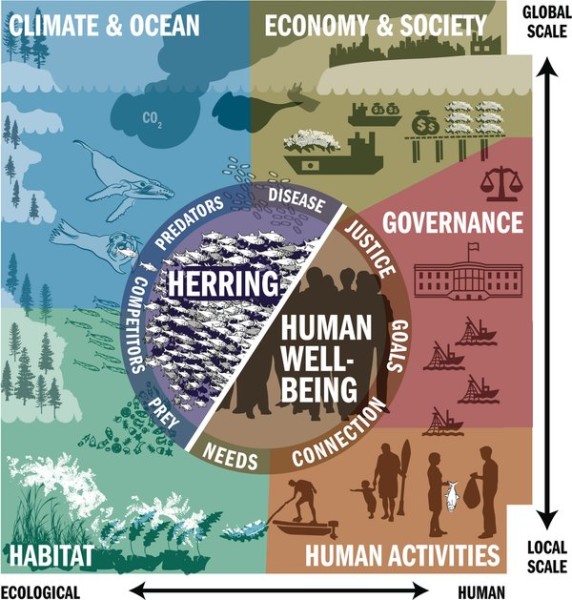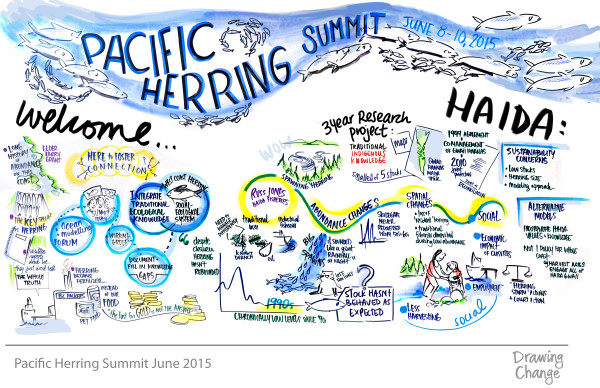Infographic for Pacific Herring – a tiny and mighty fish
This one infographic asks 32 questions: the new Conceptual Model of the Herring Social-Ecological System. The Pacific Herring is a tiny, and mighty, fish. They’re ecologically and economically important for other species and commercial fisheries.
Pacific Herring: a Cultural Keystone Species
But as importantly, these fish are interdependent with Indigenous people on the Pacific Coast – they’re a cultural keystone species. Indigenous people have harvested herring for thousands of years. The last time I was in Haida Gwaii I ate spawn-on-kelp for the first time – truly a delicacy.

This visual supports new research, “Thirty two essential questions for understanding the social-ecological system of forage fish: the case of Pacific Herring”, by authors Phillip S. Levin, Tessa B Francis and Nathan G. Taylor.
The research project and infographic design was a collaboration. It combines content from a 3-day forum, traditional ecological knowledge, and group work. This participatory process began at the Pacific Herring Summit in 2015. Participants set collaborative priorities and engaged in group work to create a conceptual model linking social-ecological systems (SES).
Graphic recording at the Summit
I was also invited to the Pacific Herring Summit before I worked on this digital model. On day 1 of the Summit, I created live graphic recordings of the traditional ecological knowledge presentations (TEK) by Indigenous groups. Then after the event, I received summary information from the group work and my team began to design and refine the working model. You can see 4 more graphic recordings at this link here.

Participatory Research
I enjoyed reading this part of the article where it talks about the participants drawing a draft model. The drawings “evolved”, and improved because of the collaboration. Just like any good design, it takes more than one try to get it right! The authors write,
“The final conceptual model benefited from the participatory process in that it evolved over the course of a 3-d discussion among a diverse group of stakeholders, which ultimately influenced perspectives on the Herring SES. The conceptual models constructed on day 2 were far narrower in scope and viewpoint than the final synthetic model. For example, several groups’ conceptual models were strictly biologically and physically oriented: Herring sat in the middle (often represented by a drawing of a generic “fish”), and around Herring were other biological components of the ecosystem in great detail: predators, nutrient flow, plankton, different life stages of Herring. Other conceptual models took a more human-centric view of the system, comprised exclusively of the human beneficiaries of Herring and Herring activities and/or Herring-associated benefits. These models were organized around services such as money, spiritual connection, storytelling, nutrition, family, and future opportunities. One such model contained neither a picture of nor the word “Herring” anywhere in the model. In contrast, the final conceptual model gives equal weight to social/cultural, ecological, and economic nodes in the Herring SES, representing the diversity of perspectives contributing to the model.”
There are 32 fantastic questions in this article, and you can read it here:
3 comments on “Infographic for Pacific Herring – a tiny and mighty fish”
Great SHARE Sam! Superb article, thank you!
Thanks Yvon, glad you liked it!